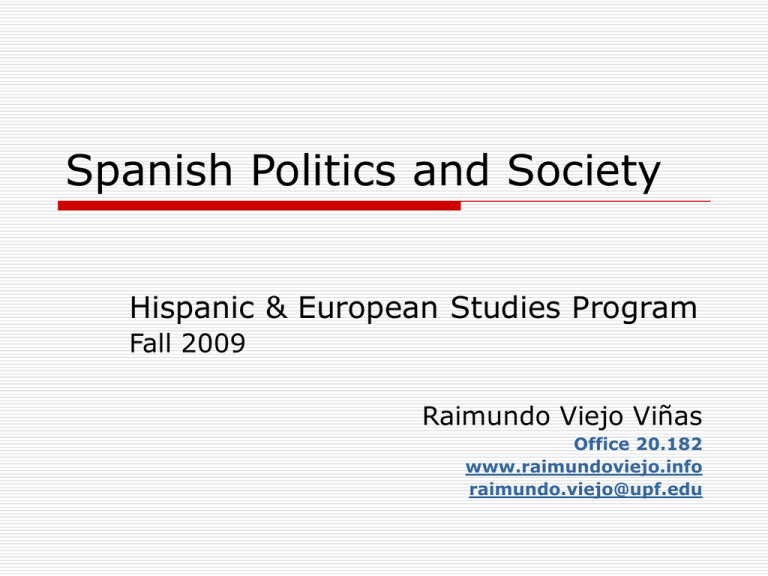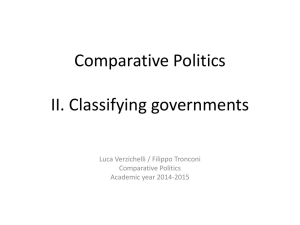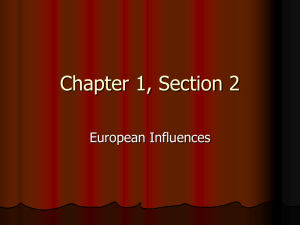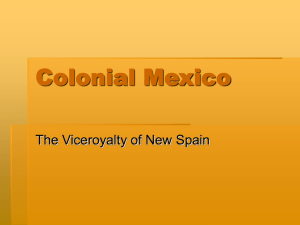Spanish Politics and Society
advertisement

Spanish Politics and Society Hispanic & European Studies Program Fall 2009 Raimundo Viejo Viñas Office 20.182 www.raimundoviejo.info raimundo.viejo@upf.edu Institutions of Spanish Democracy, 1 Parliamentarism in Spain Parliamentarism in Spain Political systems can be presidential or parliamentarian A presidential system is a form of government where an executive branch exists separately from the legislature. It has fewer ideological parties than parliamentarian systems A parlamentarian system is distinguished by the executive branch of government being dependent on the direct or indirect support of the Parliament Parliamentarism in Spain Spanish contemporary democracy is a parliamentarian political system. The executive power (i.e. the King and the Government) is not independent from the Parliament. The King’s constitutional functions are subordinated to the will of the Spanish nation represented in the Parliament The Government and the Prime Minister depend on the support of the Parliament Every week there is a special session at the Parliament to control the executive’s activity Parliamentarism in Spain Democratic regimes can be classified in two different ideal types: majoritarian and “consociative” (Lijphardt) Majoritarian or “Westminster” democracy is based on a “winner take all” principle “Consociative” or consensus democracy is animated by a solid spirit of consensus Spain can be situated in the middle of a majoritarian-consociative continuum. Spain’s democracy is defined as “the less majoritarian of the majoritarian regimes” Parliamentarism in Spain The distribution of power in the legislature depends on the type of democracy: Majoritarian democracies tend to a one single chamber Parliament There are some exceptions, like the British Parliament (the House of Lords is not a powerful chamber) Consociational democracies tend to a bicameral legislature Parliamentarism in Spain With a few exceptions, the second chamber of bicameral parliaments is subordinated to the first. The second chamber usually represents the territorial and/or cultural diversity of a country. In fact, bicameral parliaments are the most common institutional form of the legislative power in multinational societies. Parliamentarism in Spain The Spanish parliament (Las Cortes Generales or Las Cortes) is a bicameral one The first chamber is called Congreso, but it is popularly known as the Parlamento (which is incorrect from a scientific point of view). It has 350 seats. The second chamber is called Senado. It has 264 seats and it is a very controversial chamber. Parliamentarism in Spain The major political parties are represented in the Congreso de los Diputados. Elections take place (under ordinary conditions) once every four years Political parties that obtain more than five seats in elections can form their own parliamentarian group. All other parties form a single parliamentarian group called grupo mixto. Parliamentary groups: PSOE, PP, CiU, PNV, and ERC/IU/ICV (plus the grupo mixto). The comisiones parlamentarias organize the specialized work of the members of the Congreso Parliamentarism in Spain During the dictatorship, Franco awarded some old politicians with a seat in the Senado. During the transition to democracy, members of the Senado (senadores) become elected representatives. The senadores are voted through open lists (one voter can chose candidates of different political parties) At the present, the Senado is being reformed in order to better represent the territories (the so-called Comunidades Autónomas)








